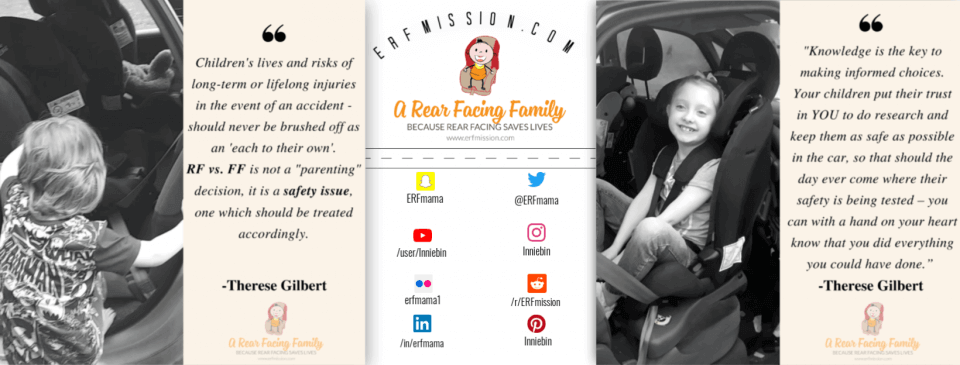Carsick…most of us have been there, and at some point, most parents will have a child who suffers from it. Maybe not on a regular basis, but sometimes it happens.
So what do you do about it?
Too often I hear (or read) that a parent chose to turn their child around FF (forward facing) too soon, because they claim carsickness, and it is then the parent’s belief that FF will cure the problem. You’ll even come across the claim that FF did cure the problem and the child is no longer carsick. The fact that the child is no longer carsick is, of course, a positive thing, no one likes to be ill, it’s neither fun or enjoyable, but FF is not the reason why the child is now “cured”.
The FACTS:
80% OF ALL PEOPLE WILL SUFFER FROM MOTION SICKNESS AT ONE TIME OR ANOTHER.
(http://www.motionsickness.org.za)
It is also a known fact (or maybe less known, but it’s still there) that women are more prone to travel sickness than men (especially during our cycle) and children between 3 and 12 years of age are disproportionally prone to motion sickness. But motion sickness is rare in children under 2 years!
The Cause?
Motion sickness is a conflict between your senses. The brain relies on messages from your inner ear, muscles, and eyes to tell how your body is moving. When any of these systems send different messages, you can get queasy.
This is often prone to happen if you ;
- Read in the car – your inner ear knows you’re moving, but your muscles think that you are sitting still and your eyes don’t see anything moving because they’re looking at the page. Ergo – conflicting messages.
- Think about being car sick – believe it or not, you can actually create it by worrying about it! Pretty cool…in an..not so cool way.
- Ate a big meal before travelling, if the air is stuffy or filled with fumes. Oh and looking at a meal is going to make it worse, so I would advise not to.
- Travel by boat. “Seasickness” happens to pretty much all of us. It’s estimated that 100% of travellers experience it. Well, at least until you get used to the motion!
- Ensure That Your Next Car Journey Is The Safest It Can Be For Your Kids
- Top 5 Wheelchair-Friendly Cars To Consider
- 5 Top Tips For Buying A Caravan
- How to Ensure a Safe Driving Environment with Your Little Ones on Board
- Surprising Things That Can Compromise Your Family’s Car Safety
Signs and Symptoms:
The most common signs and symptoms of motion sickness include:
- Nausea
- Pale skin
- Cold sweats
- Vomiting
- Dizziness
- Headache
- Increased salivation
- Fatigue
So what’s the CURE?
Believe it or not, doing more of the thing that made your car sick is going to help. Let me explain:
– You get carsick because you read in a book, or you read the map. Ergo, the more you read in the car/bus/train/plane, the less and less sick you will become until your body has adapted.
If travel sickness occurs, keeping the window open might help. Stopping the car and getting out for some fresh air is also helpful. If you are the driver and passenger(s) is feeling queasy you should try and go easy on the turns in the road as that motion is not helping. Also putting on the Air-con or open windows.
For small children who are prone to travel sickness, I would recommend “Sea bands”. You can get this at your local Boots or any other pharmacy I used them for many many months every time I went into a car, even outside the car, while I was pregnant with my daughter. I was especially car sick then and had great help from those Sea Bands.
There is ofc always medication that can be taken to prevent travel sickness, but I’m not that sort of person who uses that, but if you ask your local pharmacist they would be able to help you there.
As a closing point, let’s not forget that pretty much all children at one point or another will go through a phase where they do not want to go in the car. Not want to buckle in and so forth.
The important thing is: Never let your child dictate in-car safety that would put them at risk!
Sources:
Motion sickness: http://www.umm.edu/altmed/articles/motion-sickness-000110.htm#ixzz2UGCd1SRj
University of Maryland Medical Center:
http://www.motionsickness.org.za/motion_sickness_003.htm
http://bodyandhealth.canada.com/channel_condition_info_details.asp?disease_id=183&channel_id=9&relation_id=10860
Therese has completed the ‘Advanced Child Car Seat Training Course’ at TRL (Transport Research Lab) and is a CPD accredited car seat expert. She blogs about in-car safety, car seats, tips, reviews, giveaways and advice. She’s a mum on a mission to change the law and raise awareness. She is also a breastfeeding advocate and gentle parenting promoter who loves cloth nappies, baby-wearing, BLW and co-sleeping/bed-sharing.


